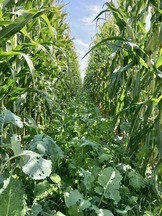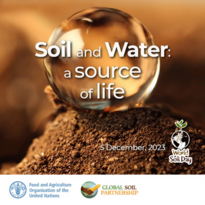|
Hello! We are Courtney Cosdon (University of Idaho Extension/Natural Resources Conservation Service) and Tasha Harder (NRCS Idaho), bringing you Idaho soil health news and information. In this newsletter, we are sharing resources to encourage the use of soil health practices and working to involve more of our community in soil health events and discussions.
-
Soil Health 5 for 5 Roundtable Meetings: March 26 at 10 a.m. Topic: Nutrient Management. All are welcome to join! Presenters give 5-minute presentations on soil health topics of interest, and then the floor is open for discussion. Join online via Zoom.
- Impromptu Field Day: March 28 from 9 a.m. to 1 p.m. A Regenerative Program from A to Z with Blake Matthews and Jared & Jason Cook. Learn about Blake’s soil health journey in his row crop-based system and about plans for a new Nature Conservancy (TNC) IAMP demonstration farm. This is the kickoff for a series of events and field days with Blake for the 2024 season. It will be at Redox in Burley, 130 S 100 W, Burley, ID 83318. RSVP to Courtney Cosdon ccosdon@uidaho.edu by March 26 for lunch, provided by Redox.
-
Twilight Tour: July 17. In person. This is an educational learning event for folks to hear about agricultural and horticultural research projects in Eastern Idaho. It will take place at the University of Idaho’s Aberdeen Research and Extension Center. For more information, visit the U of Idaho’s Extension website Aberdeen Twilight Tour page.

The Magic Valley Soil Health Forum took place on February 12 in Twin Falls at the College of Southern Idaho campus. The forum provided an opportunity for producers to gather and discuss topics in a group setting. There were 11 breakout sessions on such topics as reducing tillage, making and using compost, soil biology, livestock integration and economics, soil health economics and using data to make decisions among others. The day started out with introductions from the speakers and a new section called the “Hall of Shame” where producers shared a mistake or two that they have made along their soil health journey. As Ladd Wahlen, a producer near Aberdeen, commented "these are not failures, but learning opportunities and hearing about them is just as important as learning about success stories." Josie Erskine of Peaceful Belly Farms in Caldwell then discussed their success with receiving funding for innovative projects and ideas, and shared information about how other producers can go about this process to do the same.
Attendees were able to choose from four different breakout sessions at a time. One notable breakout session, hosted by Kurt Heward and Ryan Streadbeck of Heglar Creek Farms, included discussion on soil biology. The two went into detail about how they use a microscope to get a better understanding of the biology in their soil, with an overarching goal of increasing nitrogen (N) efficiency. In one trial, they decreased N application on one field to 100 units and 140 units, compared to their standard application of 180 units in other fields. In the field with the reduced N application, they were able to identify an abundance of nitrogen fixing microbes, which were not detected in the fields with a standard N application rate. Also, the field with reduced N yielded slightly higher than the standard rate, leading to overall savings from reduced inputs and increased yield. Kurt and Ryan ended the session emphasizing the importance of documenting the tests and experiments producers run, so that the information may be shared with others who want to learn.
|
Impromptu Field Days
Impromptu field days are quick, educational field visits to see and discuss a soil health practice that a producer is trying on their land. If you would like to host an impromptu field day and have your neighbors out to your place for a couple hours, please contact Courtney Cosdon ccosdon@uidaho.edu, (208) 364-4692
Innovative Agriculture and Marketing Partnership (IAMP-Idaho) Grant
Sign-ups begin this Spring!
The University of Idaho has secured a $55 million USDA-NRCS grant to help farmers adopt climate smart practices on Idaho’s major commodity crops including potatoes, barley, beef, chickpeas, hops, sugar beets and wheat. Do you grow any of these crops? Are you interested in incorporating practices such as cover cropping, reduced tillage, interseeding, nutrient management for reduced nitrogen applications, biochar, or grazing cattle on grounds managed using these practices? Would you like to have funding to help with the costs and risks of adoption? If so, you may be interested in this program.
Here's what you can do to get started:
-
Stay tuned to the IAMP-Idaho Website
-
Talk to representatives of any of the implementing groups. These include: your local Soil and Water Conservation district representative, The Nature Conservancy, Nez Perce or Coeur d’Alene Tribal representative, or Desert Mountain Grass fed Beef.
Early adopters and long-time practitioners of one or more of these practices are encouraged to apply. Both smaller and larger farms are welcome.
NRCS Programs Dates
The Environmental Quality Incentives Program (EQIP) provides technical and financial assistance, to producers who want to address resources concerns and implement conservation practices on their land. Call your local NRCS field office to schedule a meeting.
- EQIP-IRA signup deadline: April 5, 2024
Conservation Stewardship Program (CSP) helps landowners build upon conservation efforts already in place, while increasing resilience of the operation. CSP pays landowners for conservation performance. Call your local NRCS office to learn more!
- CSP Classic signup 2 deadline: May 3, 2024
- CSP-IRA signup deadline: June 24, 2024
Older editions of the Soil Health Minute can be found on the University of Idaho Soil Health website, under the News & Events tab.
Soil Health Institute: Economics of Soil Health Systems
An economic case study featuring Griff Farms discusses how implementing soil health practices has impacted their bottom line. View the study on the Soil Health Institute website and check out Farm 4 at the bottom of the page.
American Farmland Trust: Soil Health Case Study
A case study featuring the Purdy family in Picabo discusses the economics effects of soil health practices on their operation. View Idaho Soil Health Case Study American Farmland Trust and NRCS.pdf

|

There are a variety of lab tests available for quantitatively measuring soil health parameters. Soil organic carbon (or soil organic matter) percent is an excellent metric to measure and keep track of but can respond quite slowly to management changes. Including additional tests that look at other aspects of soil can help with monitoring soil health over time.
This publication from WSU Extension is a great resource for understanding several soil health tests: A Practical Guide to Soil Health Indicators for Monitoring Shifts in Soil Organic Matter. For each soil health indicator listed, the guide explains availability of this test in the Pacific Northwest, what it measures, and its relevance for monitoring changes when different conservation practices are adopted.
The relationship between potentially mineralizable carbon (PMC) and permanganate oxidizable carbon (POXC) is particularly interesting and is explained very well in this guide. PMC measures microbial activity in the soil; higher PMC indicates microbes are actively releasing nutrients from organic matter decomposition. On the other hand, POXC measures a specific fraction of total organic matter, and increases in this value are associated with higher levels of carbon accumulation and stabilization in soil. These two measurements are best interpreted alongside each other, because if PMC is increasing, while POXC is decreasing, this indicates soil organic matter is being lost over time. However, if both values are increasing, it suggests gains in soil organic matter over time while biological nutrient cycling is occurring. These two tests can help a landowner detect and predict trends in soil organic matter and soil health changes over time. Tests that detect soil properties which change quickly can be encouraging for growers on the path towards building soil health.
Nearly all the soil health tests mentioned in this guide are available through the NRCS CEMA (Conservation Evaluation and Monitoring Activity) 216. Read more about this CEMA at this link: CEMA 216 Soil Health Test. The NRCS will pay for a qualified individual to both collect soil samples and have the samples tested in a lab. A group of Basic Soil Health tests are available, or single indicators can be selected. The single indicators are selected by first using the In Field Soil Health Assessment to identify resource concerns. The CEMA 216 is flexible as far as which tests are scheduled. Soil health testing is encouraged to be used before and after applying a soil health conservation practice.
What would you like to see in the “In the Literature” section? Please reach out with any comments/feedback: ccosdon@uidaho.edu and tasha.harder@usda.gov
|

The Idaho NRCS Soils/GIS team recently presented a series of “Lunch and Learn” webinars on soil topics and resources. Check out this recording on the Idaho NRCS Youtube channel to learn more about World Soil Day (occurs every year on December 5). This recording focuses on soil-water relationships and the soil health principles.
|
 |
|
NRCS Idaho
9173 W Barnes Dr, Suite C
Boise, ID 83709
Phone: 208-378-5700
|
|